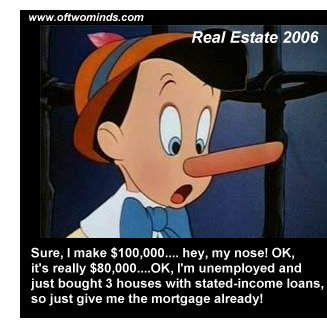

|
| weblog/wEssays archives | home | |
|
Big Lies, Small Lies and Felony Lies: Welcome to Real Estate 2006 (October 19, 2006)  Deceptive lending, deceptive listings, deceptive borrowers, deceptive buyers,
deceptive sellers--has there ever been an industry more rife with corruption and lies than
the current real estate market? Really? Where?
Deceptive lending, deceptive listings, deceptive borrowers, deceptive buyers,
deceptive sellers--has there ever been an industry more rife with corruption and lies than
the current real estate market? Really? Where?
As astonishing as the endless layers of lies is the complacency and droll acceptance of the deceit which reigns supreme in the real estate and mortgage industries. "Business as usual," now that "the market is returning to normal." Is business based on deception "normal" now? Here are the lies, big and small. Whether they are Felony lies--well, we'll just have to wait for the collapse to reach epic proportions. Then the public will demand some fall guys, and prosecutors will undoubtedly have many opportunities to pursue those who practised the many flavors of fraud and deceit which underpin this "boom." 1. Borrowing and lending (mortgages) based on lies, obfuscation and deceit 2. Re-listing houses to hide their time on market and original listing price 3. Demanding cash back from sellers, obscuring the actual selling price 4. Providing "incentives" to buyers which obscure the actual selling price Let's start with a look at the wide-spread practise of offering buyers incentives, allowing the builder or seller to propagate a false selling price, i.e. "sold at the listing price:" The Government Accountability Office told Congress last month that from 2003 to 2005, nontraditional mortgages rose from less than 10 percent of all mortgages to about 30 percent: Inflated prices potentially cause harm to banks, which could take a hit if the mortgage holder defaults and the home turns out to be worth less. It also could affect buyers of neighboring homes, who may be making decisions based on faulty data.Next up: the practise of buyers getting cash back from sellers, another way of boosting the actual selling price by tens of thousands of dollars: Some Cash-Back Home Deals May Be Illegal-- Illegal Off-The-Books Cash Back Incentives Put Lenders, Brokers and Buyers at Risk (yahoo.com)  As for deceptive borrowing and lending, consider that 80% of subprime borrowers from one
California lender lied about their income. The lender, in turn, saddled them with deceptive
option-ARM loans which will re-set to rates and payments beyond the borrowers' means. Why?
Hey, you don't make money if you don't close the loan. Once it's closed, it's sold off
in a tranched mortgage-backed security to Wall Street. Who cares what happens after that?
As for deceptive borrowing and lending, consider that 80% of subprime borrowers from one
California lender lied about their income. The lender, in turn, saddled them with deceptive
option-ARM loans which will re-set to rates and payments beyond the borrowers' means. Why?
Hey, you don't make money if you don't close the loan. Once it's closed, it's sold off
in a tranched mortgage-backed security to Wall Street. Who cares what happens after that?
From Forbes.com, October 13: Laperriere points out that 79% of FirstFed Financial (nyse: FED) loans in the first half of the year were stated-income loans, according to its latest 10-Q. Almost one-fifth of Washington Mutual's (nyse: WM) loans during the same period were option-ARMs. And at Countrywide Financial (nyse: CFC), 42% of its giant mortgage portfolio consists of option-ARMs.And from the New York Sun, evidence that the borrowing boom is national and unprecedented in scale-- and unsustainable: As an example, 62% of non-agency loans made last year had low or no income verification, up from 24% in 1998. Also,52% of such loans made in 2005 had zero or negative amortization requirements. In 1998 there were no such loans.Last but certainly not least, let's look at the mechanics of re-listing homes to mask the length it's been sitting dead on the market, and how much the price has dropped from it's original number: Re-Listing Deception: 29255 Kuhn Lane, Mechanicsville, Md 20659What would the consequences be if this deception were not allowed? Reader "Financial Expert" sent in this link to an article by a California real estate broker who describes how re-listings make a hash of real estate data. The essay concludes with a warning about what would happen should listings actually reflect their original listing data and history of price reductions: The reason I am spending so much time on this and making an effort to bring home the point is that if we are not aware of this and prepare for it, the analysts are going to have everyone believing we are on the edge of a catastrophe and the belief that they are right will bring about the catastrophe they predict.When did facts and reality get such a horrible, terrible reputation? When they threaten the housing "boom," that's when. One thing the housing industry should note: people can be conned, but reality cannot. Reality eventually trumps deceit and lies. For more on this subject and a wide array of other topics, please visit my weblog. copyright © 2006 Charles Hugh Smith. All rights reserved in all media. I would be honored if you linked this wEssay to your site, or printed a copy for your own use. |
||
| weblog/wEssays | home |